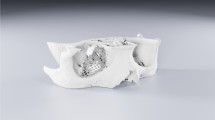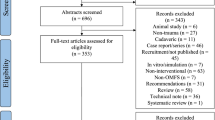Abstract
Background
Orbital floor defects from traumatic injuries can be successfully repaired surgically utilizing alloplastic implants. The objective of this study was to conduct a comprehensive systematic review of alloplastic implant materials utilized in the repair of orbital floor fractures stratified by material type, indication for surgery, and outcomes in all reported cases to date.
Methods
A comprehensive systematic review of published literature on alloplastic periorbital implant studies was conducted utilizing Medline/PubMed database without timeframe limitations. Articles were reviewed in full by multiple authors and outcomes data were collected.
Results
A total of 11 studies (n = 585 patients) were identified to meet the inclusion criteria. Overall, 25 total surgical complications (4.3%) were noted, including infection, inflammation, graft migration or explantation, and hematoma. Overall, porous polyethylene (PPE) implants were associated with the highest rate of infection (2.0%) compared with all other implant types analyzed. Poly-l-lactic acid (PLLA) implants were associated with the highest rate of graft explantation (5.9%). Explantation was required in a total 0.6% of all implants (n = 3).
Conclusions
Alloplastic implants are a reliable means of reconstructing the orbital floor following trauma. It is imperative for surgeons to understand the relative risks for each type of implant to develop postoperative complications in order to optimize outcomes.
Level of evidence: Level III, therapeutic study

Similar content being viewed by others
References
Smith B, Regan WF (1957) Blow-out fracture of the orbit*: mechanism and correction of internal orbital fracture. Am J Ophthalmol 44(6):733–739
Fujino T, Makino K (1980) Entrapment mechanism and ocular injury in orbital blowout fracture. Plast Reconstr Surg 65(5):571–576
Burnstine MA (2002) Clinical recommendations for repair of isolated orbital floor fractures: an evidence-based analysis1. Ophthalmology. 109(7):1207–1210
Cole P, Boyd V, Banerji S, Hollier LH Jr (2007) Comprehensive management of orbital fractures. Plast Reconstr Surg 120(7):57S–63S
Mok D, Lessard L, Cordoba C, Harris PG, Nikolis A (2004) A review of materials currently used in orbital floor reconstruction. Can J Plastic Surg 12(3):134–140
Chowdhury K, Krause GE (1998) Selection of materials for orbital floor reconstruction. Arch Otolaryngol Head Neck Surg 124(12):1398–1401
Iatrou I, Theologie-Lygidakis N, Angelopoulos A (2001) Use of membrane and bone grafts in the reconstruction of orbital fractures. Oral Surg Oral Me Oral Pathol Oral Radiol Endod 91(3):281–286
Johnson PE, Raftopoulos I (1999) In situ splitting of a rib graft for reconstruction of the orbital floor. Plast Reconstr Surg 103(6):1709–1711
Mintz SM, Ettinger A, Schmakel T, Gleason MJ (1998) Contralateral coronoid process bone grafts for orbital floor reconstruction: an anatomic and clinical study. J Oral Maxillofac Surg 56(10):1140–1144
Kakibuchi M, Fukuda K, Yamada N, Matsuda K, Kawai K, Kubo T, Sakagami M (2003) A simple method of harvesting a thin iliac bone graft for reconstruction of the orbital wall. Plast Reconstr Surg 111(2):961–962
Skouteris CA, Sotereanos GC (1989) Donor site morbidity following harvesting of autogenous rib grafts. J Oral Maxillofac Surg 47(8):808–812
Haug RH, Nuveen E, Bredbenner T (1999) An evaluation of the support provided by common internal orbital reconstruction materials. J Oral Maxillofac Surg 57(5):564–570
Laxenaire A, Levy J, Blanchard P, Lerondeau J, Tesnier F, Scheffer P (1997) Complications of silastic implants used in orbital repair. Rev Stomatol Chir Maxillofac 98:96–99
Klisovic DD, Katz SE, Lubow M (2002) The wayward implant: orbital silicone plate extrusion associated with squamous epithelial downgrowth and infection. Orbit. 21(2):149–154
Dougherty WR, Wellisz T (1994) The natural history of alloplastic implants in orbital floor reconstruction: an animal model. J Craniofac Surg 5(1):26–32 discussion 33
Cuzalina LA, Hlavacek MR (2009) Complications of facial implants. Oral Maxillofac Surg Clin North Am 21(1):91–104
Baino F (2011) Biomaterials and implants for orbital floor repair. Acta Biomater 7(9):3248–3266
Kirby EJ, Turner JB, Davenport DL, Vasconez HC (2011) Orbital floor fractures: outcomes of reconstruction. Ann Plast Surg 66(5):508–512
Ellis E III, Tan Y (2003) Assessment of internal orbital reconstructions for pure blowout fractures: cranial bone grafts versus titanium mesh. J Oral Maxillofac Surg 61(4):442–453
Kelly CP, Cohen AJ, Yavuzer R, Jackson IT (2005) Cranial bone grafting for orbital reconstruction: is it still the best? J Craniofac Surg 16(1):181–185
Gear AJ, Lokeh A, Aldridge JH, Migliori MR, Benjamin CI, Schubert W (2002) Safety of titanium mesh for orbital reconstruction. Ann Plast Surg 48(1):1–9
Yaremchuk MJ (2003) Facial skeletal reconstruction using porous polyethylene implants. Plast Reconstr Surg 111(6):1818–1827
Rubin JP, Yaremchuk MJ (1997) Complications and toxicities of implantable biomaterials used in facial reconstructive and aesthetic surgery: a comprehensive review of the literature. Plast Reconstr Surg 100(5):1336–1353
Garibaldi DC, Iliff NT, Grant MP, Merbs SL (2007) Use of porous polyethylene with embedded titanium in orbital reconstruction: a review of 106 patients. Ophthalmic Plast Reconstr Surg 23(6):439–444
Rubin PA, Popham JK, Bilyk JR, Shore JW (1994) Comparison of fibrovascular ingrowth into hydroxyapatite and porous polyethylene orbital implants. Ophthalmic Plast Reconstr Surg 10(2):96–103
Mackenzie DJ, Arora B, Hansen J (1999) Orbital floor repair with titanium mesh screen. J Craniomaxillofac Trauma 5(3):9–16
Nam SB, Bae YC, Moon JS, Kang YS (2006) Analysis of the postoperative outcome in 405 cases of orbital fracture using 2 synthetic orbital implants. Ann Plast Surg 56(3):263–267
Elmazar H, Jackson IT, Degner D, Miyawaki T, Barakat K, Andrus L, Bradford M (2003) The efficacy of Gore-Tex vs. hydroxyapatite and bone graft in reconstruction of orbital floor defects. Eur J Plast Surg 25(7–8):362–368
Park DJ, Garibaldi DC, Iliff NT, Grant MP, Merbs SL (2008) Smooth nylon foil (SupraFOIL) orbital implants in orbital fractures: a case series of 181 patients. Ophthalmic Plast Reconstr Surg 24(4):266–270
Cordewener FW, Bos RR, Rozema FR, Houtman WA (1996) Poly (L-lactide) implants for repair of human orbital floor defects: clinical and magnetic resonance imaging evaluation of long-term results. J Oral Maxillofac Surg 54(1):9–13
Balogh C, Lucas R, Kraft T, Breton P, Freidel M (2001) Lactic acid polymer implants in the repair of traumatic defects of the orbital floor. Rev Stomatol Chir Maxillofac 102(2):109–114
Bergsma JE, De Bruijn WC, Rozema FR, Bos RR, Boering G (1995) Late degradation tissue response to poly (L-lactide) bone plates and screws. Biomaterials. 16(1):25–31
Jank S, Emshoff R, Schuchter B, Strobl H, Brandlmaier I, Norer B (2003) Orbital floor reconstruction with flexible Ethisorb patches: a retrospective long-term follow-up study. Oral Surg Oral Med Oral Pathol Oral Radiol Endod 95(1):16–22
Büchel P, Rahal A, Seto I, Iizuka T (2005) Reconstruction of orbital floor fracture with polyglactin 910/polydioxanon patch (ethisorb): a retrospective study. J Oral Maxillofac Surg 63(5):646–650
Acknowledgements
The authors would like to acknowledge Michelle K. Higgins, PhD from the Mayo Clinic School of Medicine in Scottsdale, AZ for her methodological input.
Author information
Authors and Affiliations
Corresponding author
Ethics declarations
Conflict of interest
Jeremie D Oliver, Elias S Saba, Nikita Gupta, Tina M Hendricks, and Davinder J Singh declare that they have no conflict of interest.
Statement of human and animal rights, or ethical approval
This article does not contain any studies with human participants or animals performed by any of the authors.
Informed consent
For this type of study, informed consent is not required.
Additional information
Publisher’s note
Springer Nature remains neutral with regard to jurisdictional claims in published maps and institutional affiliations.
Rights and permissions
About this article
Cite this article
Oliver, J.D., Saba, E.S., Gupta, N. et al. Alloplastic reconstruction of orbital floor fractures: a systematic review and pooled outcomes analysis. Eur J Plast Surg 43, 109–116 (2020). https://doi.org/10.1007/s00238-019-01614-x
Received:
Accepted:
Published:
Issue Date:
DOI: https://doi.org/10.1007/s00238-019-01614-x




